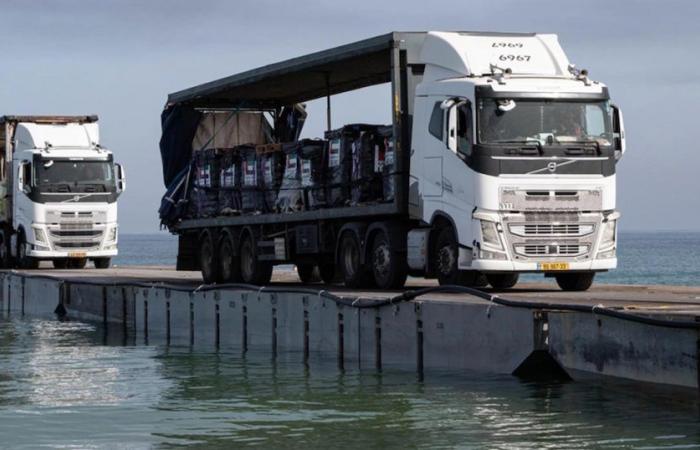The US Department of Defense announced on Friday that the floating dock that was built off the coast of the Gaza Strip by the US military to deliver aid to the Palestinian population has been removed, and will likely not be rebuilt. The decision to remove the pier, whose construction was completed in mid-May, shows the failure of the Joe Biden administration’s project: costing 320 million dollars, the pier had already been dismantled and reassembled several times due to various problems , and contributed only minimally to the delivery of humanitarian aid to the civilian population of Gaza.
The reasons for the failure of the pier are numerous: first of all the technical difficulties of building a floating pier in the open sea, which exposed the structure to the elements; and secondly the logistical difficulties of delivering aid to the Palestinian population. Mainly due to the military activities of the Israeli army in the area, very few aid trucks managed to arrive at the UN depots for distribution.
The floating pier had been announced in March by Joe Biden’s administration as a way to alleviate the terrifying conditions of the civilian population of the Gaza Strip, which especially in that period had no access to humanitarian aid: in those weeks there were various testimonies of people and children dying of hunger. From the announcement, the Biden administration had made it clear that the pier would be an emergency solution, and above all a partial one: on its own it would not have been able to meet the needs of the population of Gaza, but it could have helped alleviate hunger at a time when the passage of aid through land crossings had been blocked by the Israeli army. Under full capacity, just over a quarter of the aid needs of the Gaza Strip should have passed through the pier: this has never happened.
A satellite image of the pier in mid-May (US Central Command via AP)
After some delays, the construction of the pier was completed in mid-May. It was a rather complicated infrastructure.
The temporary pier (whose official name is JLOTS: Joint Logistics Over-the-Shore, which can be translated as “coordinated logistics on the coast”) was composed of two parts: a large floating platform anchored off the Strip and the real pier and precisely, which was connected directly to the coast with a long walkway, made so that trucks could pass over it. Humanitarian aid arrived from Cyprus via large cargo ships, and docked at the floating platform offshore. The aid was then unloaded on the platform and loaded onto smaller military ships, which transported it to the pier anchored to the coast. From there they were finally loaded onto trucks that took them to the mainland, where they were delivered to the UN World Food Program mission, which would take care of distribution.
From the first days of its operation, the pier had problems and suffered setbacks. Among other things, delivering aid to the population was very difficult because all the structures for maintaining order in the Gaza Strip had collapsed, and convoys leaving from the coast towards the interior of the Strip were systematically attacked by desperate Palestinians.
Just over 10 days after opening, at the end of May, the pier’s activity had already been suspended due to damage caused by bad weather: parts of the pier were dismantled for repairs. On June 8, the pier was reopened, but that same day Israel carried out a violent military operation in the pier area, in which it recovered four Israeli hostages alive, but killed more than 270 Palestinians.
In the operation, two warehouses of the World Food Program – the UN agency that was responsible for distributing aid – were hit by rockets. At that point the director of the World Food Program announced the interruption of aid distribution work from the pier, because it was no longer possible to guarantee the safety of her employees. The UN also feared that its neutrality might be compromised, because rumors had circulated that the US military had made pier facilities available to support Israel in the military operation (the military denied this).
Since then, the World Food Program has never resumed aid deliveries. The US military continued for a while to bring humanitarian aid to the coast via the pier, and to store it in protected staging areas. But with no one to distribute it, humanitarian aid is effectively blocked. On Friday, with the marshalling areas on the coast now at maximum capacity, the army announced the removal of the pier.
In fact, therefore, the pier operated at full capacity for about ten days, from mid-May to the end of the month, while in June it limited itself to accumulating aid in the sorting areas on the coast, which however were not delivered. In total, according to the United States, 8,831 tons of aid were brought to Gaza via the pier, of which however approximately 4,500 tons are still stuck in the sorting areas.






